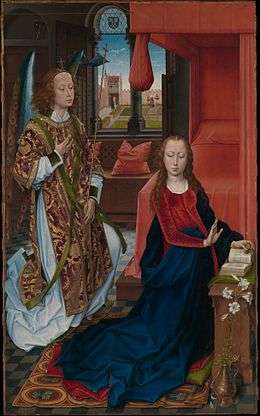Ave Maria, WAB 7
| Ave Maria | |
|---|---|
| Motet by Anton Bruckner | |
|
| |
| Key | F major |
| Catalogue | WAB 7 |
| Form | Marian hymn |
| Text | Ave Maria |
| Language | Latin |
| Composed | 5 February 1882: Vienna |
| Dedication | Luise Hochleitner |
| Performed | 5 February 1903: Vienna |
| Published | 1902: Stuttgart |
| Vocal | Alto soloist |
| Instrumental | Organ, piano or harmonium |
Ave Maria (Hail Mary), WAB 7, is a setting of the Latin prayer Ave Maria by Anton Bruckner.
History
When staying in Wels during the summer of 1881 Bruckner met Luise Hochleitner, a singer with a beautiful alto voice.[1] Bruckner promised to dedicate to her an Ave Maria. The work, which was composed on 5 February 1882, —almost 20 years after his more famous motet— is for alto (or baritone) solo voice and keyboard (organ, piano or harmonium).[2]
It was published in 1902 as an appendix to No. 13 of the Neue Musikzeitung, Stuttgart.[3] The first public performance occurred during a concert of the Wiener Akademischer Wagner-Verein on 5 February 1903 by Gisella Seehofer, who then also premiered Bruckner's Wie bist du, Frühling, gut und treu and Im April.[4] The motet is put in Band XXI/29 of the Gesamtausgabe.[5]
Setting
The 81-bars, demanding work, scored in F major, requires a singer with a 2-octave broad tessitura.
Alike the two earlier settings of Ave Maria the name Jesus is sung thrice (bars 23-31).[3] It is followed by an instrumental interlude (bars 32-38) and goes then on with the second part (Sancta Maria), which quotes the 20-year earlier setting.[3] Thereafter (bars 53-58) Nunc et in hora mortis nostrae is sung pianissimo in unison. After a repeat of Sancta Maria, it is ending by a two-octave descending arpeggio on Amen (from F5 to F3) and a short instrumental postlude (bars 76-81).
Selected discography
The first recording was:
- Ingrid Günther (alto), Herbert Günther (BRT-Radio-Sinfonie-Orchester), Bruckner – Missa Solemnis in B – LP: Garnet G 40 170, c. 1980
In the majority of the about 20 recordings the singer is skipping the lower octave of the Amen. A selection among the few recordings, in which the singer is doing it faithfully:
- Anne-Marie Owens (mezzo-soprano), Peter King (organ), Mass No. 2 / Motets (Simon Halsey) – CD: Conifer CDCF 192, 1990
- Peter Matuszek (baritone), Vladimir Roubal (organ), Canti Sacri – CD: Rosa RD 151-2, 1994
- Sigrid Hagmüller (alto), Rupert Gottfried Frieberger (organ), Anton Bruckner – Oberösterreichische Kirchenmusik – CD: Fabian Records CD 5112, 1995
- Vera Ilieva (mezzo-soprano; transposed to A-flat major), Burhard Pütz (organ), Ave Maria – CD: CSD 100 057, 1999
References
- ↑ C. van Zwol, p. 269
- ↑ "Anton Bruckner / Ave Maria". Carus-Verlag. Retrieved 6 October 2014.
- 1 2 3 C. van Zwol, p. 707
- ↑ C. van Zwol, p. 718
- ↑ Gesamtausgabe - Kleine Kirchenmusikwerke
Sources
- Anton Bruckner - Sämtliche Werke, Band XXI: Kleine Kirchenmusikwerke, Musikwissenschaftlicher Verlag der Internationalen Bruckner-Gesellschaft, Hans Bauernfeind and Leopold Nowak (Editor), Vienna, 1984/2001
- Cornelis van Zwol, Anton Bruckner 1824-1896 - Leven en werken, uitg. Thoth, Bussum, Netherlands, 2012. ISBN 978-90-6868-590-9
External links
- Ave Maria, WAB 7: Scores at the International Music Score Library Project
- Ave Maria F-Dur, WAB 7 (1856) Critical discography by Hans Roelofs (German)
- The following live performances can be heard on YouTube:
- Ewa Mikulska (contralto), Andrzej Mikulski (organ), 2011: Ave Maria, WAB 7
- Tatiana Rubinskaya (mezzo-soprano), Anasyasiya Sidelnikova (organ), 2012: Ave Maria, WAB 7
- Martha Swiderska (mezzo-soprano) with string quartet accompaniment, 2013: Ave Maria, WAB 7
- Ulrike Martin with piano accompaniment: Ave Maria, WAB 7
